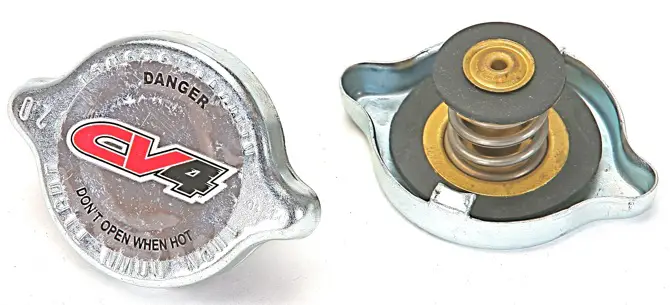MXA TEAM TESTED: CV4 HIGH-PRESSURE RADIATOR CAP

WHAT IS IT? CV4’s radiator cap increases the boiling point of the water in your bike’s radiator by increasing the amount of pressure. The radiator cap actually increases the boiling point of your coolant by about 45 degrees Fahrenheit (25 degrees Celsius). How does this simple cap do this?
WHAT’S IT COST? $22.73 (Japanese brands), $29.95 (KTM, Husaberg, Husqvarna), $22.73 (minis).
CONTACT? www.cvproducts.com or your local dealer.
WHAT STANDS OUT? Here’s a list of things that stand out with CV4’s high-pressure radiator cap.
(1) Concept . A motorcycle’s radiator cap is similar to the safety valve on a chef’s pressure cooker. Since the boiling point of water increases when the water is placed under pressure, a radiator cap has a coil spring situated between two rubber seals. The stiffness of the spring determines how much pressure the water is under. As the water heats up, it expands. This expansion puts pressure on the radiator cap’s spring. When the radiator’s internal pressure exceeds the spring rate of the radiator cap, the hot coolant escapes and overflows between the two rubber seals.
(2) Temperature control . Without any pressure on it, water will boil at 212 degrees Fahrenheit. However, a cooling system that is under 15 pounds of pressure will allow straight water to reach nearly 250 degrees before it boils. When you pressurize a 50/50 mix of water and antifreeze to 15 pounds, it won’t boil until 280 degrees. For every pound of pressure exerted on the coolant, the static boiling point is raised by 3 degrees.
(3) Measurement. There are many measurements of pressure. Most motorcycles use kilograms per centimeter squared (kg/cm2), American cars use pounds per square inch (psi), scientists use kilopascals (kPa) and European cars use barometric pressure (bar). Conversion charts are available to turn any measurement system into another, but motorcycle racers only need to worry about converting bar, psi or kPa to kg/cm2.
(4) Stock caps . Most bikes come with 1.1 kg/mm2 radiators caps; Kawasaki uses a 1.6 cap, and KTMs come with 1.8 kg/mm caps. A 1.1 kg/cm2 cap can handle 14.22 psi before the coolant pushes the valve open and steam comes out of the overflow. By increasing the radiator cap to 1.8, the radiator can handle 25.6 psi, while a 2.0 cap ups the ante to 28.45 pounds. The higher the pressure, the longer the water in your radiator will resist boiling.
(5) Function. The MXA wrecking crew always changes the stock 1.1 radiator caps on Honda, Yamaha and Suzuki motocross bikes. In the past, we have used 1.6 Kawasaki radiator caps, but with CV4 offering a 2.0 kg/cm2 cap, which is the equivalent of 176 kPa, 1.96 bar or 28.45 psi, we can easily stop our test bikes from puking out water on the starting line or steaming like a Turkish sauna after a mud race.
WHAT’S THE SQUAWK? Unless he is frustrated by overheating issues, there is no reason for a KTM or Kawasaki owner to switch to a high-pressure radiator cap.

Radiator caps are not rocket surgery or brain science. They are simple spring-loaded devices that raise the boiling point of water. Water is what cools the delicate internals of your expensive engine. If the water inside boils, you will have an expensive doorstop.





Comments are closed.